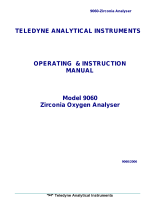
October 2016
TN03 520-1002 Rev 3
Technical note
MTL gas analysers & systems
Eaton Electric Limited,
Great Marlings, Butterfield, Luton
Beds, LU2 8DL, UK.
Tel: + 44 (0)1582 723633 Fax: + 44 (0)1582 422283
www.mtl-inst.com
© 2016 Eaton
All Rights Reserved
Publication No. TN03 520-1002 Rev 3
October 2016
The Use of Zirconia Oxygen Analysers
in Heat Treatment
The MTL Zirconia Oxygen analysers can be used to measure
the properties of a heat treatment atmosphere (carburising,
annealing etc.) by measuring the amount of oxygen in
them.
In a carburising furnace, a hydrocarbon, typically natural gas or
propane, is "cracked" to provide the atmosphere. The "cracking"
is really burning with too little oxygen, so that not all the carbon
and hydrogen in the fuel gas is used up. The equations below
illustrate this, using methane (natural gas) as fuel.
Stoichiometric combustion (stoichiometric means exactly the
right amount of one chemical to react with another) looks like
this:
CH4 + 2O2 = CO2 + 2H2O
But if you "crack" the fuel with too little oxygen, you get this:
4CH4 + 4O2 = 2CO + 2CO2 + 2H2O + 6H2
However, this is only one possible reaction. Depending on
temperature, you could get:
= CO + 3CO2 + H2O + 7H2
or even
= 3CO + CO2 + 3H2O + 5H2
The other effect to be considered is dissociation, or the break-
down of a molecule when heated. It is a reversible reaction and
the equation must remain numerically balanced at a particular
temperature. Both carbon dioxide and water will dissociate at
the high temperature of our analyser, and the resulting output
from the cell would be due to the oxygen from this break-down:
2H2O = 2H2 + O2 . . . . . . (i)
2CO2 = 2CO + O2 . . . . . . .(ii)
Both water and carbon dioxide dissociate equally at one
particular temperature, 812°C. As the equations must remain
numerically balanced at a given temperature - if you increase
the amount of (say) carbon monoxide in equation (ii), some of
the oxygen will be used up to convert it to carbon dioxide. So
the amount of oxygen present measures the ratio between
carbon dioxide and carbon monoxide, and between water
and hydrogen, which are both the same at 812°C. Oxygen is
proportional to H2O/H2 and CO2/CO
The general formula for the cell output at 812°C is:-
O/P (mV) = 950 - 107.7 log OXIDES
FUELS
So a measure of oxygen made at 812°C will tell you the combined
ratios of oxides to fuels, directly. At any other temperature, you
also need to know the carbon/hydrogen ratio of fuel.
Referring back at the three equations for excess methane and
oxygen. If you count up the molecules of oxide gases and
divide by the molecules of fuel gases, you will find that the ratio
is 1:2 in all cases. So it does not matter just how the methane
is cracked - with a particular amount of oxygen - we will always
finish up with the same ratio of oxides to fuels.
The significance of this ratio is that it determines how much
carburising potential a gas has. But the water and hydrogen
play their parts too, because too much water will provide some
oxygen that will combine with the carbon monoxide to form
carbon dioxide, and it is the carbon monoxide that does the
carburising.
So now our single measurement can replace three "traditional"
measurements; those of carbon monoxide, carbon dioxide and
dewpoint. Our single oxides-to-fuels measurement tells the
user all that is required - but the user may feel that it cannot be
interpreted in the accustomed fashion.
So for practical purposes, we can ignore the hydrogen/
water break-down, and concentrate on the carbon monoxide/
carbon dioxide. The graph shows cell output against carbon
monoxide/carbon dioxide ratio. This is plotted at 634°C and
812°C - being the two principal temperatures that our analysers
are operated at - although for metallurgical processes 812°C is
the more usual. We find however that more often than not
users "calibrate" our analyser output against what they regard as


